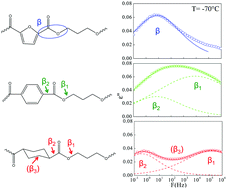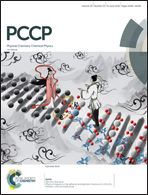Effect of chemical structure on the subglass relaxation dynamics of biobased polyesters as revealed by dielectric spectroscopy: 2,5-furandicarboxylic acid vs. trans-1,4-cyclohexanedicarboxylic acid†
Abstract
The chemical structure–dynamics relationship for poly(trimethylene 2,5-furanoate) and poly(trimethylene 1,4-cyclohexanedicarboxylate) was investigated via dielectric spectroscopy and compared with that of poly(trimethylene terephthalate) in order to evaluate the impact on the subglass dynamics of the chemical nature of the ring. Further comparison was accomplished with the neopentyl glycol containing counterparts: poly(neopentyl 2,5-furanoate) and poly(neopentyl 1,4-cyclohexanedicarboxylate). Our study reveals a multimodal nature of the subglass β process. For the more flexible polymers (containing cyclohexane rings) three modes for the β process were detected. The faster mode was assigned to the relaxation of the oxygen linked to the aliphatic carbon, the slower one to the link between the aliphatic ring and the ester group, and the third mode to the aliphatic ring. For stiffer polymers (containing aromatic rings), the local modes appear more coupled. This effect is more evident in the polymers with the furan ring where essentially a single β mode can be resolved.

- This article is part of the themed collection: 2018 PCCP HOT Articles


 Please wait while we load your content...
Please wait while we load your content...